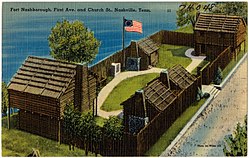Fort Nashborough | |
Formerly listed on the U.S. National Register of Historic Places | |
 A historical reconstruction of Fort Nashborough | |
| Coordinates | 36°9′51″N 86°46′28″W / 36.16417°N 86.77444°W |
|---|---|
| Architect | North Carolina Militia (Overmountain Men) |
| Architectural style | log stockade |
| NRHP reference No. | 11000454 |
| Significant dates | |
| Added to NRHP | July 13, 2011 |
| Removed from NRHP | November 24, 2015 |
Fort Nashborough, also known as Fort Bluff, Bluff Station, French Lick Fort, Cumberland River Fort and other names, was the stockade established in early 1779 in the French Lick area of the Cumberland River valley, as a forerunner to the settlement that would become the city of Nashville, Tennessee. The fort was not a military garrison. The log stockade was square in shape and covered 2 acres (8,100 m2). It contained 20 log cabins and was protection for the settlers against wild animals and Indians. James Robertson and John Donelson are considered the founders, and colloquially, the "founders of Tennessee". The fort was abandoned in 1794, but the settlement, now the city of Nashville, became the capital of the new state of Tennessee in 1843.

